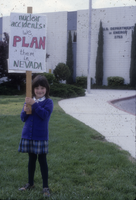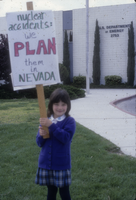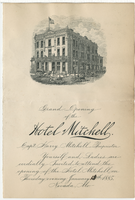Search the Special Collections and Archives Portal
Search Results

Unidentified protestor outside of United States Department of Energy Building: photographic slide
Date
Archival Collection
Description
From the Sister Klaryta Antoszewska Photograph Collection (PH-00352). The protest sign reads, "Nuclear accidents: we plan them in Nevada."
Image

Unidentified protestor outside of the United States Department of Energy Building: photographic slide
Date
Archival Collection
Description
From the Sister Klaryta Antoszewska Photograph Collection (PH-00352). The protest sign reads, "Nuclear accidents: we plan them in Nevada."
Image

Grand opening of the Hotel Mitchell, invitation, Thursday, January 1, 1885
Date
Archival Collection
Description
Restaurant: Hotel Mitchell Location: Nevada, Missouri, United States
Text
Center Stage, Inc. Records
Identifier
Abstract
The Center Stage, Inc. Records (1994 to 2008) are comprised of photographs, bylaws, correspondence, meeting minutes, publicity, scripts, programs, cast lists, and video cassettes of a number of the productions. Center Stage Theater Inc. was the first LGBT theater company in Las Vegas, Nevada.
Archival Collection
Robin Holabird Film Press Kit Collection
Identifier
Abstract
The Robin Holabird Film Press Kit Collection is comprised of press kits for commercial Hollywood films dating from 1986 through the first decade of the 2000s that were compiled by Robin Holabird in her capacity as Deputy Director of the Nevada Film Commission. The kits contain press releases, photograph stills and other filming information.
Archival Collection
John G. (Jack) Fogliani Photograph Collection
Identifier
Abstract
The John G. (Jack) Fogliani Photograph Collection is comprised of two black-and-white photographic reprints created between approximately 1971 and 2004 of the natural landscape of Eagle Valley, Nevada. The original photographs were taken between approximately 1900 and 1920.
Archival Collection
Eberhardt and Aurora Mining Company Records
Identifier
Abstract
The Eberhardt and Aurora Mining Company Records (approximately 1869-1877) are comprised of the administrative records and financial documents of the mining company located in White Pine County, Nevada. The majority of the collection contains correspondence, but also includes several documents relating to the company's finances such as bills, receipts, cancelled checks, and bank statements.
Archival Collection
Nevada Official Bicentennial Book Collection
Identifier
Abstract
The Nevada Official Bicentennial Book Collection (1975) contains materials related to the editing and publication of the book by the Nevada American Revolution Bicentennial Committee. It includes article submissions about Nevada history as well as a small amount of correspondence to Stanley Paher, the editor of the book.
Archival Collection
L. Paul Mercer Papers
Identifier
Abstract
The L. Paul Mercer Papers date from 1939-1970 and consist of personal correspondence, newspaper clippings, photographs, and textile samples dyed in the Native American tradition.
Archival Collection
Paul May Papers
Identifier
Abstract
The Paul May Papers (1963-1984) contain correspondence, reports and minutes from the Nevada Legislature, campaign materials, and invitations to various events.
Archival Collection
